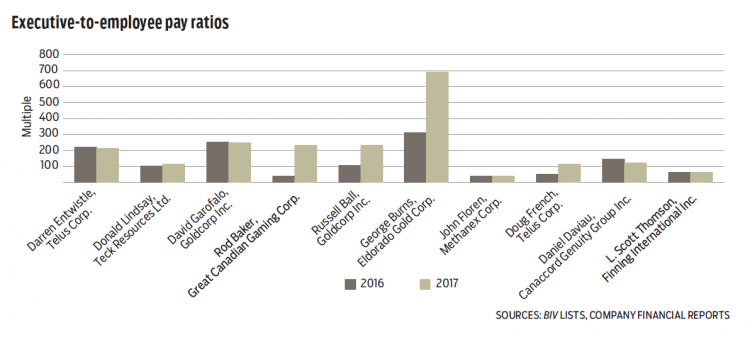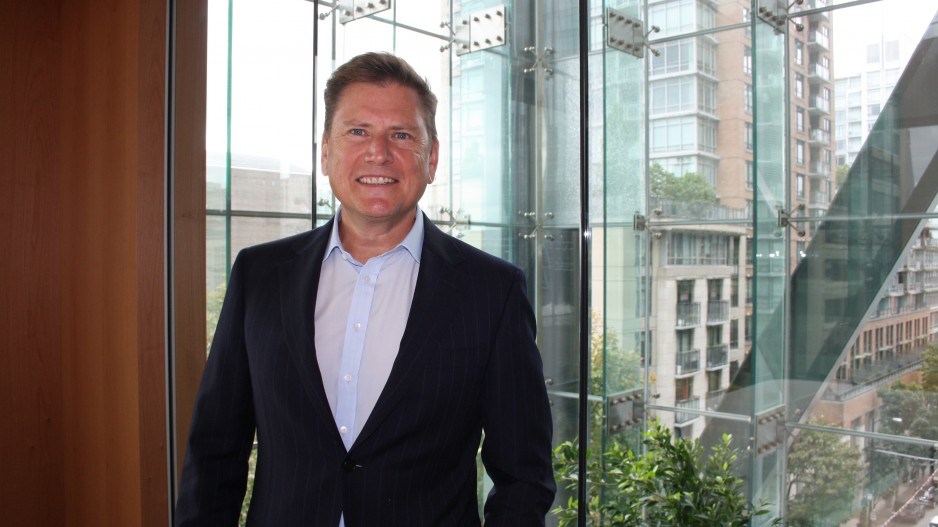The average compensation for B.C.’s highest-paid executives was 207 times the average employee’s wage at their respective companies last year, based on Business in Vancouver data.
In 2017, the average compensation for the 10 highest-paid B.C. executives at companies for which employee wage data was available was $8.1 million. Employees at the same companies made on average $64,700.
The executive-to-employee ratio was calculated by dividing the executive’s annual compensation by the average employee’s salary for each company. The 207 ratio was calculated by averaging all 10 executive-to-employee pay ratios.
The group’s largest wage gap was at Eldorado Gold Corp. (TSX:ELD), where CEO George Burns was paid 689.2 times the average salary of an Eldorado employee. Ranked at No. 9 on BIV’s Top 100 Highest-Paid Executives in B.C. list, Burns’s 2017 compensation of $7.3 million compared with the company’s average employee compensation of $10,638.

Executive pay tends to be determined by industry type, business size, corresponding executive compensation in the U.S. and whether the executive is a member of the board of directors, said Kenneth Thornicroft, professor of law and employee relations at the University of Victoria’s Gustavson School of Business.
“This idea that there’s a market and people are paying market wages, the evidence would suggest that it’s a bit of a fiction.”
Thornicroft added that a decline in unionism and the loss of jobs to outsourcing and automation could be contributors to the rising disparity between executive and employee compensation.
According to statistics Thornicroft presented at a 2018 conference for the Continuing Legal Education Society of BC,, the average Canadian CEO’s pay rose 25% to $10.4 million in 2017 from $8.3 million in 2010.
Thornicroft noted that a large compensation increase for a CEO, even if it’s in the millions of dollars, will be less expensive than a minor wage increase applied across its entire workforce.
Large wage gaps could be hampering economic growth, said Mark Thompson, professor emeritus at the University of British Columbia’s Sauder School of Business.
“You wonder why the economy isn’t growing faster when the largest portion of our economy is consumer consumption,” Thompson said. “The economy is not growing because wages aren’t growing … commensurate with profit or productivity.”
The growing wage gap could also be exacerbating B.C.’s labour shortage. Low wages paired with high costs of living make it difficult for employees or potential employees to live in the region.
Thompson added that the wage gap could also affect internal business operation dynamics by accelerating employee turnover.
The executive-employee pay gap in B.C. is slightly smaller than its national counterpart. According to Canadian Centre for Policy Alternatives data, the top 100 CEOs nationally make 209 times the average Canadian income.
Methanex Corp.’s (TSX:MX) president and CEO had the smallest gap. He was paid 33.2 times the compensation of the company’s average employee.
In 2017, John Floren, No. 11 on BIV’s list, made $6.97 million, compared with $179,592 for Methanex’s average employee, based on BIV calculations. In 2017, Floren’s compensation grew by 15.3% from $6.04 million in 2016. During the same period, Methanex’s average employee’s compensation grew 11.8% from $160,597 in 2016.
The compensation of the 10 executives analyzed by BIV grew by an average of 84.5% during the same period, compared with an average employee compensation growth across their respective companies of 1.52%.
At the same time, median executive compensation grew by 14.3% in 2017 from 2016 compared with a median average employee earnings growth of 1.6% for the 10 companies.
Four of the 10 companies reported a wage gap decrease in 2017 from 2016. However, the average wage gap decline for the four companies, at 8.8%, was significantly smaller than the 138.8% average wage gap growth at the remaining six companies. Canaccord Genuity Group Inc.’s (TSX:CF) 17.3% wage gap decline was the largest in the group. In 2017, the compensation of Canaccord’s president and CEO, Daniel Daviau, dropped to 121.3 times the company’s average employee compensation from 146.6 times in 2016. The largest wage gap growth was at the Great Canadian Gaming Corp. (TSX:GC), at 461%. Its president and CEO, Rod Baker, was paid 231.3 times the company’s average employee wage in 2017 compared with 41.23 times in 2016. •




